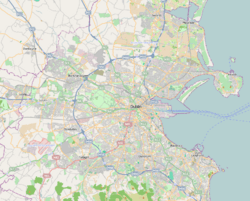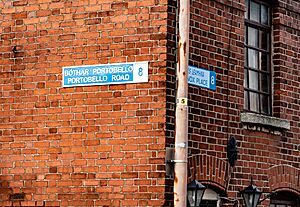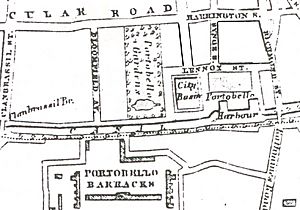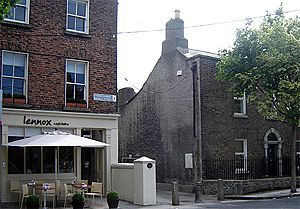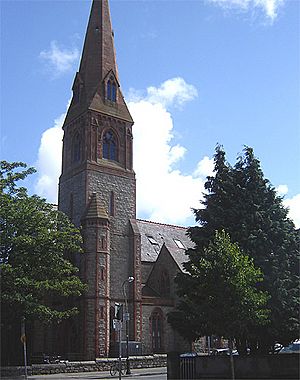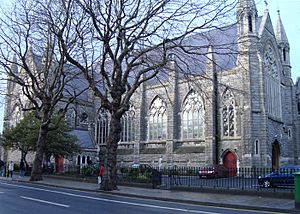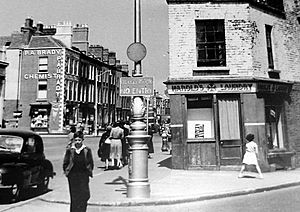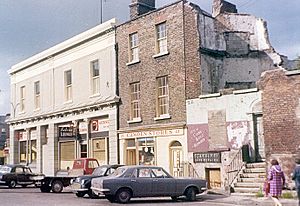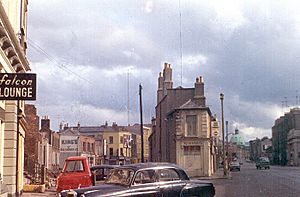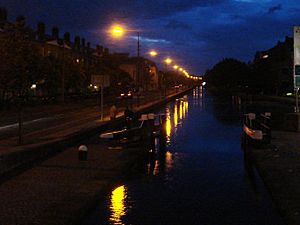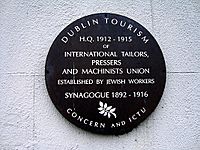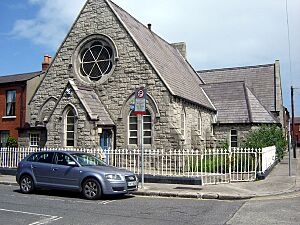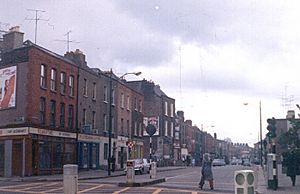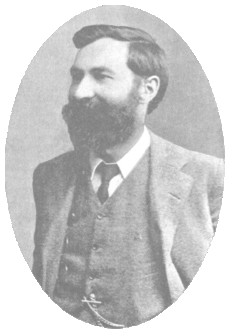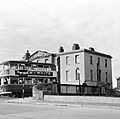Portobello, Dublin facts for kids
Quick facts for kids
Portobello
An Cuan Aoibhinn
|
|
|---|---|
|
Inner suburb
|
|

Portobello, Dublin
|
|
| Country | Ireland |
| Province | Leinster |
| City | Dublin |
| Dáil constituency | Dublin Bay South |
| EU Parliament | Dublin |
| Time zone | UTC+0 (WET) |
| • Summer (DST) | UTC-1 (IST (WEST)) |
Portobello (Irish: Cuan Aoibhinn, meaning 'beautiful harbour') is a lively area in Dublin, Ireland. It's located in the southern part of the city centre, right next to the Grand Canal. This area started as a small suburb in the 1700s, with Richmond Street at its heart.
During the 1800s, Portobello grew quickly. Many families who were doing well moved here. Their children later became important people in politics, arts, and science. Towards the end of the 1800s, many Ashkenazi Jewish families came to Portobello. They were escaping difficult times in Russia and Eastern Europe. Because of this, Portobello became known as Dublin's "Little Jerusalem."
Portobello is in the Dublin 8 postal district. This is also called D08 in the Eircode system. It's part of the Dublin South East Inner City area for local elections and the Dáil constituency of Dublin Bay South.
Contents
- Exploring Portobello's Past
- Portobello's "Little Jerusalem"
- Important Buildings and Groups
- Famous People from Portobello
- Moments in Portobello's History
- 1861: A Sad Accident at Portobello Bridge
- 1914: The Pork Butchers Attack
- 1916: The Easter Rising and Portobello
- 1916: The Murder of Francis Sheehy-Skeffington
- 1920: Trouble in Richmond Street
- 1920: The Shooting of Harry Kells
- 1922: Erskine Childers' Trial at Portobello Barracks
- 1923: The Stamer Street Shooting
- 1966: Nelson's Head Disappears
- Images for kids
Exploring Portobello's Past
The name Portobello also refers to a part of the Grand Canal. This stretch goes from Robert Emmet Bridge to La Touche Bridge. La Touche Bridge is often called Portobello Bridge, but its real name comes from William Digges La Touche, a director of the Grand Canal Company. Like other places named Portobello, Dublin's area got its name from the capture of Portobelo in Panama in 1739. This happened during a conflict between the United Kingdom and Spain.
Battles and Pubs: The 1600s in Portobello
A long time before Portobello got its name, a big battle happened nearby. It was called the Battle of Rathmines. In the 1640s, during the Irish Confederate Wars, soldiers from Wicklow would raid the area, taking cattle and horses. Later, Irish and Royalist forces tried to take Dublin. Their army, led by the Duke of Ormonde, was defeated. Many soldiers died in the area between Rathmines and Ranelagh. This place was known as the Bloody Fields. The famous Bleeding Horse pub on Camden Street is said to have gotten its name from a horse that wandered there after the battle.
The Bleeding Horse pub is thought to be one of Dublin's oldest pubs, possibly opening in 1649. Famous writers like James Joyce and Oliver St. John Gogarty knew this pub well.
Life in the 1700s
Portobello was part of the Manor of St. Sepulchre, which was one of Dublin's special areas. The courthouse and jail for this manor were located at the corner of Long Lane and New Bride Street. The old courthouse building is still there today.
Portobello in the 1800s and 1900s
The Barracks: A Military History
The Cathal Brugha Barracks, originally called Portobello Barracks, was built between 1810 and 1815. It has been used continuously ever since.
In 1817, a man named William Windham Sadlier made a successful flight in a hot air balloon. He flew all the way from Portobello Barracks to Holyhead in North Wales!
The barracks became General Michael Collins' military headquarters after the Irish War of Independence. Collins even lived in the barracks hospital. He left from here on the day he was killed in 1922.
The Grand Canal Basin
The Grand Canal in Dublin opened in 1796, and Portobello Harbour started being used in 1801. In 1812, Richmond Basin (also called the "City Basin") opened. It was a water reservoir for the south side of Dublin. Later, people found the water quality wasn't good enough. So, a new water supply from the Vartry Reservoir was finished in 1863.
The Grand Canal Hotel
The Grand Canal Hotel opened at the harbour in 1807. In 1858, a group of nuns took it over and used it as a home for blind girls. Later, it was sold and became a hotel again, popular with officers from the nearby barracks. In the 1900s, the building became a nursing home.
Grubb's Observatory: Stargazing in Portobello
Thomas Grubb (1800–1878) was a famous optician who made telescopes. He built his first telescope in a small house near Portobello Bridge. He then set up a public observatory at 1 Upper Charlemont Street. His company, the Grubb Telescope Company, made telescopes for observatories all over the world, including one of the largest at the time for Markree Observatory in County Sligo.
Growing Portobello: New Homes and Streets
Most of Portobello was built in the second half of the 1800s. Houses along the South Circular Road were built between 1850 and 1870. Smaller houses off Lennox Street were built later, starting in 1885. These were ready just as more Jewish families were looking for homes in the area.
In 1868, a new street was opened to connect Harold's Cross with Lower Clanbrassil Street. It was meant to be called Kingsland Street, but it became Upper Clanbrassil Street instead.
Getting Around: Transport in Portobello
From the 1850s, horse-drawn buses helped people travel from Rathmines to the city centre along South Richmond Street. On October 6, 1871, work began on the Dublin tram system near Portobello Bridge. Trams started running the next year, connecting Rathgar, through Richmond Street, to College Green. Trams were much cheaper than the old buses.

Improvements were also made to Portobello Bridge around this time. Even with trams, a curve in Richmond Street near Lennox Street caused traffic problems, but it was never removed and is still there today.
Portobello Gardens: Fun and Entertainment
Part of Lennox Street, Victoria Street, and Florence Street used to be the Kingsland estate. This area had a park with a large pond and fountains, which opened as the Royal Portobello Gardens in 1839. The name Kingsland Park Avenue still reminds us of this.
From 1858, the gardens were leased by Mssrs. Kirby and Webb. Kirby was a pyrotechnician (someone who makes fireworks). In the summer, the gardens were lit up with lamps, and a band played music. People could watch acrobats, dancers, and even trained performing dogs. And, of course, there were fireworks!
In June 1850, the famous circus owner Pablo Fanque (who was later mentioned in a The Beatles song) brought his circus to the gardens. He put on big equestrian shows.
A huge attraction was the tightrope walker Charles Blondin, who first performed in August 1860. He was famous for crossing Niagara Falls on a tightrope. One time, he even cooked omelettes while suspended on the wire! However, on August 23, 1860, the tightrope broke at Portobello Gardens, and two workers fell to their deaths.
Plans to build houses on the land where the gardens were started around this time. Frederick Stokes, a developer and Chairman of the Rathmines Township Commissioners, bought the land.
Kingsland Park: A Street's New Name
The original name of Victoria Street was Kingsland Park. It was developed from 1865. Some houses on this street were empty for a while and gained a bad reputation. Because of this, respectable families moved out, and the street's name was changed to Victoria Street. Other streets like Liverpool Road also changed names to improve their image.
Emorville Estate: From Cricket to Homes
Across from Portobello Gardens was the Emorville Estate. It was sold and developed starting in the mid-1860s. Today, Emorville Avenue marks the spot. Before it became houses, the Leinster Cricket Club used it as their grounds until 1865.
Street Names: A Glimpse into History
Many older streets in Portobello, like Richmond, Harrington, Lennox, Heytesbury, and Camden, were named after British Viceroys. Newer streets were often named after the estates they were built on. Stamer Street, built around 1880, was named after Sir William Stamer, who was Lord Mayor twice.
The main employer in the area for many years was Ever-Ready Batteries at Portobello Harbour. The factory is now closed, and the space is used for small businesses and apartments. The rest of Portobello Harbour was drained and filled in 1948.
In the 1960s, the Garda Club opened on Harrington Street. The Bleeding Horse pub changed its name to The Falcon for a while.
Starting in the 1980s, Kelly's Corner was redeveloped. Old buildings were replaced by the Camden Court Hotel.
In the 1990s, more offices, apartments, and the Hilton Hotel were built. The Falcon pub was renovated and became The Bleeding Horse again. A few years later, the Luas tram system started running on the old Harcourt Street-Bray railway line.
Today, community groups meet in St. Kevin's Hall. A monthly market is held behind the Bernard Shaw pub.
The area where Portobello Harbour used to be is now a leisure spot, often used for skateboarding. Nearby are shops, pubs, and restaurants, making the area lively. South Richmond Street is part of Dublin's "Golden Mile" of music venues and bars.
The Grand Canal has been restored and is now a beautiful place for locals to enjoy.
Portobello's "Little Jerusalem"
Portobello was known as "Little Jerusalem" because it was the heart of Dublin's Jewish community in the early 1900s. The first Jewish families, escaping difficult conditions in Lithuania, arrived in the 1870s. They settled near Lower Clanbrassil Street.
As they became more successful, many moved to areas like South Circular Road, Longwood Avenue, and Bloomfield Avenue. A Jewish school even opened on Bloomfield Avenue. The main shopping area for the Jewish community was along Lower Clanbrassil Street. Here, you could find many Jewish shops and businesses alongside Irish ones. For a long time, local children would earn money by helping Jewish families on their Sabbath, as Jewish law prevents certain activities on that day.
Myer Wigoder, who founded a well-known family business, came from Lithuania after a difficult event. He started a Hebrew class and a synagogue in Camden Street. His son Harry was a famous soccer player. Another son, a doctor, married into the family of Harry Bradlaw, a dentist who became a community leader. Bradlaw founded a synagogue and a cemetery. Ada Shillman, also from Lithuania, came to Dublin in 1892 and became a midwife. She started a clinic for Jewish women and helped create Saint Ultan's Children's Hospital.
In 1902, James Connolly, a Socialist candidate, was the only one to print his election leaflets in Yiddish for the area.
The International Tailors, Machinists and Pressers' Trade Union was started in 1908 by Jewish clothing workers from the South Circular Road area. Its main office was at 52 Camden Street.
After World War II, many Jewish families left the area, some moving to Israel and others to New York. While most of Dublin's Jewish population now lives in Terenure, a few still remain in Portobello. Their old shops and schools are no longer there.
The Irish Jewish Museum is located on Walworth Road. It has interesting items, including a Guinness bottle with a Hebrew label. The long-standing Kosher bakery, the Bretzel, is still in Lennox Street, though under new management.
In 2022, six special memorial stones called Stolpersteine were placed at St. Catherine's National School. They remember six Irish Jews who were killed during the Holocaust. These stones honor Ettie Steinberg and her family, and Isaac Shishi, who were murdered. They also remember Ephraim and Jeanne Saks, who were killed. These individuals had moved to Europe before World War II.
During the 1916 Easter Rising, Jewish women from Portobello helped the rebels. They secretly moved ammunition from Dublin's Jewish quarter to Sackville Street. The artist Estella Solomons hid ammunition under a vegetable patch at her family home. Women from Cumann na mBan were able to move ammunition without being caught because they were women.
Important Buildings and Groups
The main school in the area is Synge Street CBS. This school was the setting for the award-winning 2016 film, Sing Street. The movie was filmed in Dublin, including places around Portobello like St. Kevin's Catholic Church on Harrington Street. The school was built next to the Christian Brothers monastery in 1871. St. Kevin's Hall, next to the school, used to be a meeting place for the Catholic Boy Scouts and Girl Guides.
There used to be a Jewish school on Bloomfield Avenue and synagogues on Walworth Road (now the Jewish Museum) and Adelaide Road, but these are now closed. On Adelaide Road, a Presbyterian Church (still open) was built in 1841. In 1863, a smaller chapel for the Irvingites was built, which later became St. Finian's Lutheran church (also still open).
Many Muslims living in the area attend the Dublin Mosque on the South Circular Road. There is also a centre on Harrington Street. The local Church of Ireland church, St. Kevin's, was built in 1883. It closed in the 1970s and has been nicely turned into apartments. The church buildings next door became a community centre. The small church at the top of Victoria Street used to be a Methodist Church. After closing in the 1950s, it was used as a women's employment office.
Portobello College was a private school started in 1989. It was later taken over by the Institute of Education and then by the Dublin Business School. Students moved to a different location. In 2011, a large Indian educational group, the Rayat Bahra Group, opened the Lamrin Business School nearby.
In 2009, a new cultural centre called The Lantern opened in the Christian Brothers monastery on Synge Street. It aims to bring people of different cultures and faiths together. The name "lantern" honors Nano Nagle, who helped those in need. She inspired Edmund Ignatius Rice to found the Congregation of Christian Brothers.
In May 2011, a Visitors Centre was opened at Cathal Brugha Barracks. It remembers those who fought for Ireland's independence.
Famous People from Portobello
Many interesting people have lived in Portobello over the years. In the 1700s and early 1800s, wealthier citizens lived in the area. Later, as smaller streets were built, people from different backgrounds moved in. By the 1900s, some of the grand houses had become crowded apartments, while richer areas like Terenure and Rathgar became popular for the wealthy. Here are some notable people connected to Portobello:
- Eamonn Andrews (1922–1987), a famous radio and TV presenter, was born on Synge Street.
- The Black family, including singers Mary Black and Frances Black, grew up on Charlemont Street.
- Leopold Bloom, a fictional character in James Joyce's novel Ulysses, lived at "52 Clanbrassil Street."
- Harry Boland (1887–1922), an Irish republican politician, lived on Lennox Street.
- Philip Brady (1898–1995) owned a pharmacy at Kelly's Corner and was a politician and Lord Mayor.
- Abraham William Briscoe, whose son Robert became Dublin's first Jewish Lord Mayor, lived on Emorville Avenue.
- Denis O'Dea, an actor, came from Richmond Street.
- Cearbhall Ó Dálaigh (1911–1978), the fifth President of Ireland, lived on Portobello Road.
- Barry Fitzgerald (1888–1961), an Abbey actor who won an Oscar, was born on Walworth Road.
- Chaim Herzog (1918–1997), the sixth President of Israel, grew up on Bloomfield Avenue. His father was the first Chief Rabbi of Ireland.
- Immanuel Jakobovits (1921–1999), who was Chief Rabbi of Ireland, lived on Bloomfield Avenue.
- Harry Kernoff (1900–1974) was an Irish painter who lived and worked on Stamer Street. He painted many scenes of Dublin.
- Grace Plunkett (1888–1955), a famous artist, died on South Richmond Street.
- Cornelius Ryan (1920–1974), a journalist and author known for his World War II books, was born on Heytesbury Street.
- George William Russell (1867–1935), the writer and painter known as AE, lived on Emorville Avenue.
- John Hughes (1865–1941), a notable Irish sculptor, lived on Lennox Street.
- Cecil Sheridan (1910–1980), an actor and lyricist, lived on South Circular Road.
- The parents of James Joyce, the famous writer, stayed on Emorville Avenue.
- Paul Smith (1920–1997), a writer, was born near Portobello Bridge.
- Lord Edward FitzGerald, a leader in the 1798 Irish Rebellion, had a hiding place at Portobello Harbour.
- Henry Grattan, a famous politician, had a house near Portobello Bridge.
- The playwright George Bernard Shaw (1856–1950) was born on Synge Street.
- Captain Jack White (1879–1946), who helped start the Irish Citizen Army, lived on Harrington Street.
- Jack Butler Yeats (1871–1957), the painter, lived in a nursing home at Portobello Harbour before he died.
Moments in Portobello's History
1861: A Sad Accident at Portobello Bridge
On April 6, 1861, a terrible accident happened near Portobello Bridge. A horse-drawn bus was going up the bridge when the horses got scared and backed the bus through the wooden rails. The bus, horses, and six passengers fell into the canal lock, which was about 6 meters (20 feet) deep. Even with quick help from people nearby, everyone inside the bus drowned. This included the father of the Gunne brothers, who later opened the Gaiety Theatre.
After this tragedy, passengers on horse-drawn vehicles had to get off and walk across Portobello Bridge. Some stories say that the ghost of a lock-keeper, who had drowned himself, was to blame for the accident.
1914: The Pork Butchers Attack
On August 15, 1914, during World War I, some anti-German attacks happened in Dublin. One shocking event was at George Reitz Pork butchers at Leonard's Corner in Portobello. A crowd, reportedly led by a new soldier, destroyed the shop and stole its contents. The police were criticized for not stopping the mob. The Irish Citizen Army worried that nearby Jewish shops would be attacked next.
1916: The Easter Rising and Portobello
During the Easter Rising in 1916, a group from the Irish Citizen Army took a position at Portobello Bridge. This was to allow time for defenses to be built in the city centre. Their leader, a man named James Joyce (not the famous author), used Davy's Bar near the bridge as a military outpost.
1916: The Murder of Francis Sheehy-Skeffington
Also during the Easter Rising, on April 25, the peaceful activist Francis Sheehy-Skeffington was arrested by British soldiers near Portobello Bridge. He was pasting up leaflets asking people to stop looting. He was taken to Portobello Barracks. Later that evening, he was taken out with a raiding party. The soldiers, led by Captain J.C. Bowen-Colthurst, mistakenly raided the shop of Alderman James Kelly at Kelly's Corner. They arrested two journalists there and damaged the shop. On the way back, Bowen-Colthurst and his group killed two unarmed civilians.
The next morning, Captain Bowen-Colthurst ordered a firing squad to shoot Sheehy-Skeffington and the two journalists. They were shot in the back and buried in shallow graves in the barracks yard. The British authorities tried to keep the killings quiet. An officer named Sir Francis Fletcher-Vane tried to have Bowen-Colthurst arrested for murder, but he was removed from the army for his actions. Bowen-Colthurst later pleaded insanity and was sent to a mental health facility. He was released quietly and moved to Canada.
1920: Trouble in Richmond Street
On March 22, 1920, a group of British soldiers were returning to Portobello Barracks after a night out. They started bothering people and causing trouble. At Kelly's Corner, a crowd gathered and threw stones at them. Gunfire broke out, and a running fight happened along the street. Armed soldiers from the barracks arrived, and more gunfire occurred. A van driver and a woman were killed, and many people were hurt.
1920: The Shooting of Harry Kells
On April 15, 1920, British troops carried out a very large raid in Portobello, including the "Jewish quarters." This happened because Detective Constable Harry Kells was shot the day before on Camden Street and later died. Kells had been identifying republican prisoners. It was thought that two Sinn Féin members, Michael and William Kavanagh, who Kells had identified, might be hiding in the area. Over 100 people were arrested that day.
1922: Erskine Childers' Trial at Portobello Barracks
In November 1922, Erskine Childers was arrested by Irish Free State troops. He was taken to Portobello Barracks in Dublin. On November 17, he was put on trial for having a revolver. He was sentenced to death. His execution caused a lot of anger both in Ireland and abroad.
1923: The Stamer Street Shooting
On November 14, 1923, two Jewish men were shot, and one of them, Emmanuel Kahn, died. They were returning home from the Jewish Social Club. The shooting followed an argument with soldiers from the Irish National Army. The taxi driver that night was charged with murder but fled. The reason for the murders was a mystery for a long time. Files released in 2007 suggested that a commander who had a personal dislike for Jewish people was the main person responsible.
1966: Nelson's Head Disappears
In 1966, a group of students from the National College of Art and Design stole the head of Lord Nelson's Pillar. The pillar had been blown up by Irish nationalists in March 1966. The head was stored in a shed near Clanbrassil Street. The students broke in, put the head in a car, and drove off with it. The head later appeared in many different places.
Images for kids
-
A Dublin tramways tram crosses over the Grand Canal


